A clean cat tower isn't just a luxury—it's a necessity for the health and happiness of your feline friend. Cats are naturally fastidious creatures, and a well-maintained tower can provide a safe, comfortable space to play, relax, and watch their environment.
Regular cleaning ensures this personal space remains inviting and free from irritants and helps extend the tower's life. Removing accumulated fur, dirt, and allergens promotes a healthier living environment and prevents wear and tear, keeping the cat tower/cat tree sturdy and functional for years to come. Make cleaning a regular part of your pet care routine to give your cat the fresh, clean play area they deserve.
What You'll Need To Clean A Cat Tree
To keep the cat tree clean, here’s a list to help you gather what you need:
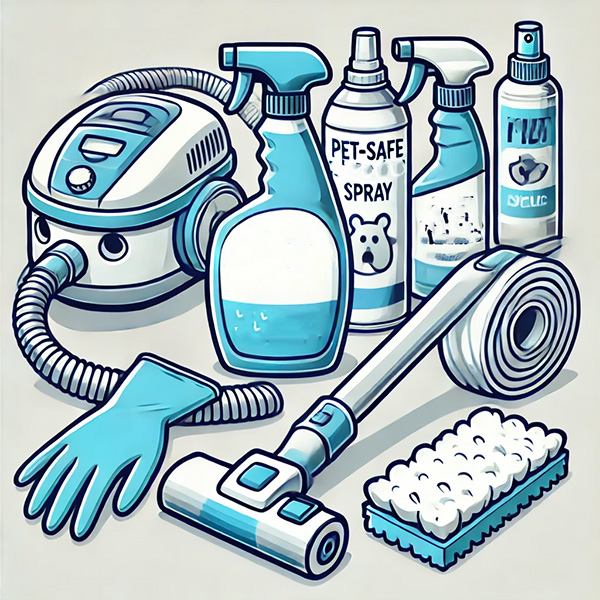
Essential Cleaning Supplies:
Vacuum Cleaner with Attachments: Ideal for removing fur, dust, and small debris from the cat tree. Use brush attachments to get into nooks and crannies and an upholstery tool for fabric-covered areas.
Mild Detergent: Select a gentle, non-toxic detergent to clean fabric components without the risk of irritating your cat's skin. Dilute the detergent according to the manufacturer's instructions and use it to wipe down surfaces.
Pet-Safe Disinfectant: Choose a disinfectant specifically formulated to be safe around pets. These disinfectants effectively eliminate pathogens while minimizing the risk of exposing your cat to harmful chemicals.
Lint Roller: An easy-to-use tool for removing loose fur and lint from the cat tower’s surfaces. This is especially handy for a quick clean-up between deeper cleaning sessions.
Gloves: Keep your hands safe from dirt and cleaning agents. Disposable or reusable gloves can prevent skin irritation, especially when using disinfectants.
Sponge or Brush: A sponge is useful for soft surfaces and can be used with your detergent solution to clean fabric areas. A stiff brush works well for scrubbing sisal posts and tougher stains.
Optional Supplies:
Enzymatic Cleaner: These cleaners are excellent for neutralizing organic odors and stains such as urine, feces, or vomit. The enzymes eliminate the bacteria responsible for odors, resulting in a fresher cat tree.
Baking Soda: A natural deodorizer that's safe to use around pets. Apply baking soda to the cat tree and let it sit for several hours or overnight. Afterward, vacuum it up to eliminate odors.
Steam Cleaner: For a deep clean, a steam cleaner can sanitize and refresh all the fabrics on your cat tree without chemicals. Make sure the materials can handle the heat and moisture.
Microfiber Cloths: These are used to wipe down surfaces after they have been cleaned. Microfiber is effective at trapping dust and dries quickly, making it ideal for final touches.
Water-Dampened Cloth: Useful for a final rinse or wipe down to remove any detergent residue, ensuring that the tree is safe and comfortable for your cat.
Clean A Cat Tree Step-by-Step Cleaning Guide
Step 1: Disassemble and Pre-Clean
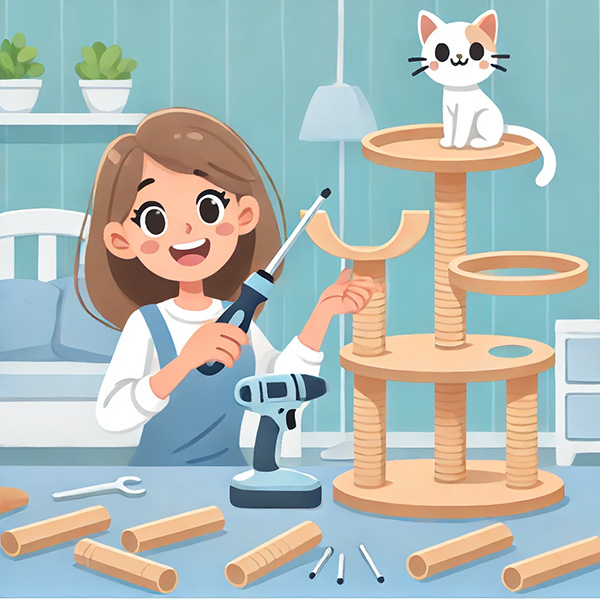
Before diving into the deep clean, the first crucial step in maintaining your cat's cat tree is to disassemble and pre-clean. This step lays the groundwork for a thorough cleaning, addressing every nook and cranny. Begin by carefully dismantling the cat tower and removing any removable parts such as cushions, toys, or platforms. This not only makes it easier to clean each component effectively but also helps you inspect each part for wear or damage.
Step 2: Remove Cat Hair
Keeping your cat tower free of hair enhances its appearance and maintains a healthier environment for your cat and home. Regularly removing cat hair is key. Start with a thorough vacuuming using an upholstery attachment to capture loose fur effectively. For more stubborn hair, a lint roller or a damp rubber glove can be invaluable; simply glide over the fabric surfaces, and the friction will pick up the hair.
Additionally, integrating a de-shedding tool into your pet's grooming routine can significantly reduce the amount of hair on the tower. To keep the tower looking neat and tidy, tackle cat hair at least once a week.
Step 3: Deep Cleaning Fabrics
Deep cleaning of the fabric components of your whole cat tree is essential for your feline friend's appearance and health. Start with a thorough vacuuming using an upholstery attachment to extract all the hair, dander, and dirt from all fabric surfaces and nooks. This prepares the fabric for a more detailed clean. Certain cat trees feature removable fabric covers that can be easily washed in the machine.
Once disassembled, start the pre-clean by vacuuming all surfaces with a brush attachment to remove loose dirt, dust, and loose cat hair. Pay special attention to areas where cat hair and debris accumulate, such as corners and hidden spots within the structure. This initial vacuuming helps reduce the cleaning workload later and ensures a more efficient and effective cleaning process.
Treat any visible stains or heavily soiled areas with a pet-friendly carpet shampoo, cat shampoo, or a mild detergent solution. Gently scrub these spots with a soft brush or sponge to lift the dirt without damaging the fibers. For overall freshness, consider using a steam cleaner if the fabric is compatible, as steam can penetrate deeply and effectively remove lingering odors and bacteria.
Rinse any cleaned areas with a damp cloth to remove soap residue, ensuring the fabric is left safe and comfortable for your pet to enjoy. Let the cat tree air dry completely in a well-ventilated area before reassembling it.
Step 4: Cleaning Hard Surfaces
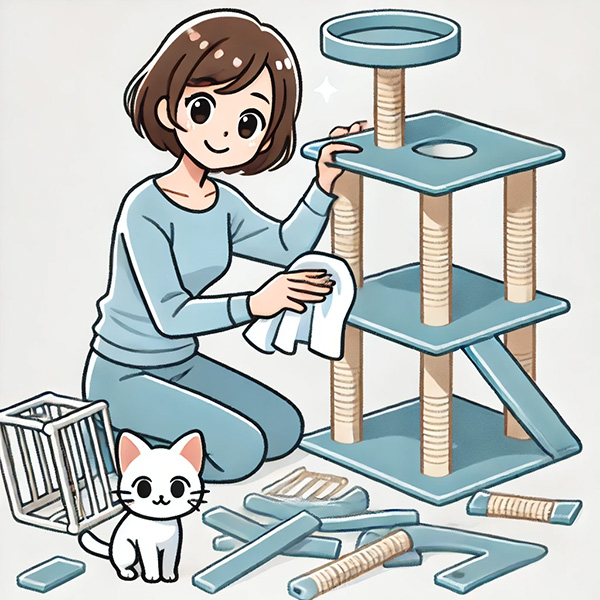
Cleaning the hard surfaces of a used cat tree is a crucial step in maintaining its durability and your pet's health. Begin by wiping down all wooden, plastic, or metal parts with a soft cloth dipped in a mixture of mild detergent and warm water. This solution efficiently cleans dirt without harming surfaces. For tougher stains or sticky residues, a gentle scrub with a non-abrasive sponge can be effective.
Once the surfaces are clean, apply a pet-safe disinfectant to eliminate any bacteria or viruses that might be lingering. Ensure the disinfectant is appropriate for the material of your cat tree to prevent any damage. Rinse the surfaces with a damp cloth to remove any soap or disinfectant residue, ensuring no harmful chemicals are left behind. Complete the process by meticulously drying all hard surfaces with a clean, dry cloth. This prevents water marks and ensures the structure is completely dry before your cat uses it again.
Step 5: Stain and Odor Removal
Stain and odor removal is key to keeping your used cat tree fresh and inviting. Over time, cat trees can accumulate stains from spills, accidents, or general use, as well as unpleasant odors. To address these issues, begin with an enzymatic cleaner made specifically for cleaning up after pets. These cleaners effectively break down organic substances like urine, vomit, and saliva, thereby eliminating odors at their origin rather than just covering them up.
Apply a stain remover or a mixture of mild detergent and water to the affected areas for visible stains. Gently scrub with a soft brush to lift the stain without harming the fabric or material. Ensure that the area is thoroughly rinsed with clean water to prevent any residue that may attract additional dirt or potentially harm your cat.
Once you've addressed the stains and odors, ensure the cat tree dries thoroughly in a well-ventilated space. Regular maintenance using these methods will keep the cat tree looking and smelling better and create a healthier environment for your feline friend.
Step 6: Disinfecting
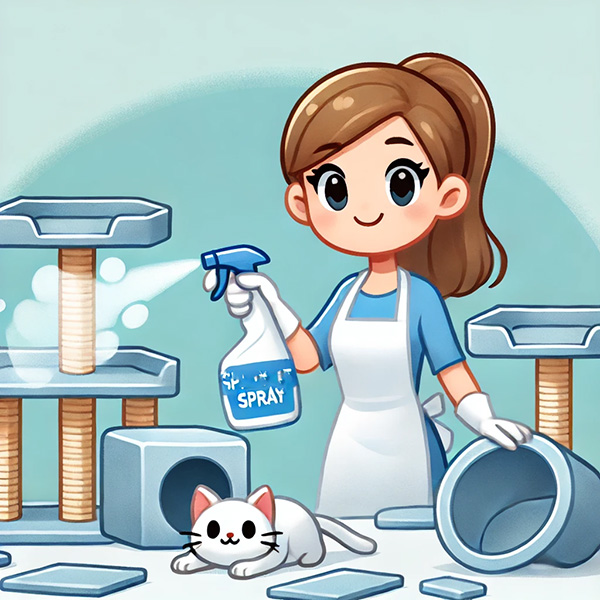
Disinfecting a used cat tree is essential in your cleaning routine, ensuring that your pet's environment is clean and hygienically safe. Begin by selecting a disinfectant that is effective against a wide range of pathogens yet safe for use around pets. Many pet-friendly products will specifically note their safety for animals on the label.
Spray or wipe down all surfaces of the cat trees, focusing particularly on areas your cat frequents. Allow the disinfectant to sit for the recommended duration to effectively eradicate germs and bacteria. It's crucial to follow this by wiping the surfaces with a damp cloth to remove any residual disinfectant, ensuring your cat isn't exposed to any potentially harmful chemicals. Complete the process by ensuring the tree dries thoroughly in a well-ventilated space.
Step 7: Drying
It is essential to properly dry your cat tree after cleaning to prevent mold and mildew, ensuring its safety and durability. After washing and disinfecting, use a clean, dry cloth to thoroughly wipe down all surfaces and remove excess moisture.
Position the cat tree in a well-ventilated area or under a fan to expedite the drying process for optimal results. Ensure every part, especially those with thick fabrics or hidden corners, is completely dry before reassembling. Regular and thorough drying not only preserves the integrity of the cat tree but also keeps it fresh and inviting for your furry friend.
Step 8: Reassembly and Final Touches
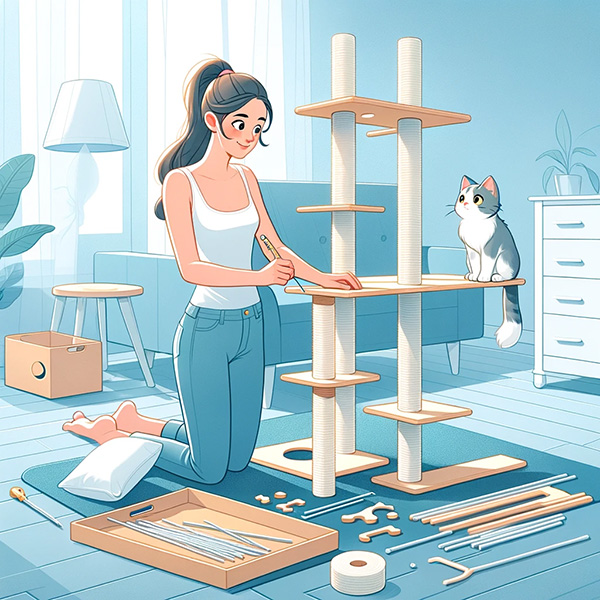
Once your cat tree is clean and dry, reassembling it is the final step to returning it to its prime condition. Carefully reconstruct each component, ensuring that all parts are secure and stable. This is a great time to tighten any loose screws or reinforce any areas that seem worn out, which can enhance the safety and longevity of the cat tree. For a finishing touch, add fresh toys or replace old ones to rekindle your cat’s interest. A little spritz of catnip spray can also make the tower irresistible, ensuring it’s clean and a delightful haven for your feline friend.
Maintaining Your Cat Tower
Maintaining your cat tower is key to ensuring it remains a clean, safe, and engaging space for your furry friend. Regular upkeep extends the tower's life and keeps your home more hygienic and pleasant. Here are some suggestions to help maintain your cat tower in excellent condition:
Weekly Vacuuming
Incorporate weekly vacuuming of the cat tree into your routine. Use the brush attachment to remove cat fur, dust, and other debris from all surfaces, especially in crevices and fabric-covered areas.
Immediate Spot Cleaning
Accidents are inevitable, but prompt action is crucial when they occur. Clean up spills or any other mess immediately using a cat-safe cleaning spray or a cleaner specifically designed for pet stains. This prevents stains from setting in and odors from lingering.
Regular Disinfecting
Use a pet-safe disinfectant to wipe down the cat tree periodically, especially after messes. This will help keep the environment sanitary and free from harmful microbes.
Thorough Cleaning Schedule
Schedule a thorough cleaning every six months or more often, depending on how frequently the cat tree is used. This involves disassembling the tower if possible, deep cleaning all parts with appropriate cleaners, and thoroughly drying everything before reassembly.
Check for Wear and Tear
During each thorough cleaning, inspect the cat trees for any signs of wear or damage. Tighten loose screws, replace worn-out toys, and make any necessary repairs to keep the tower safe and functional.
